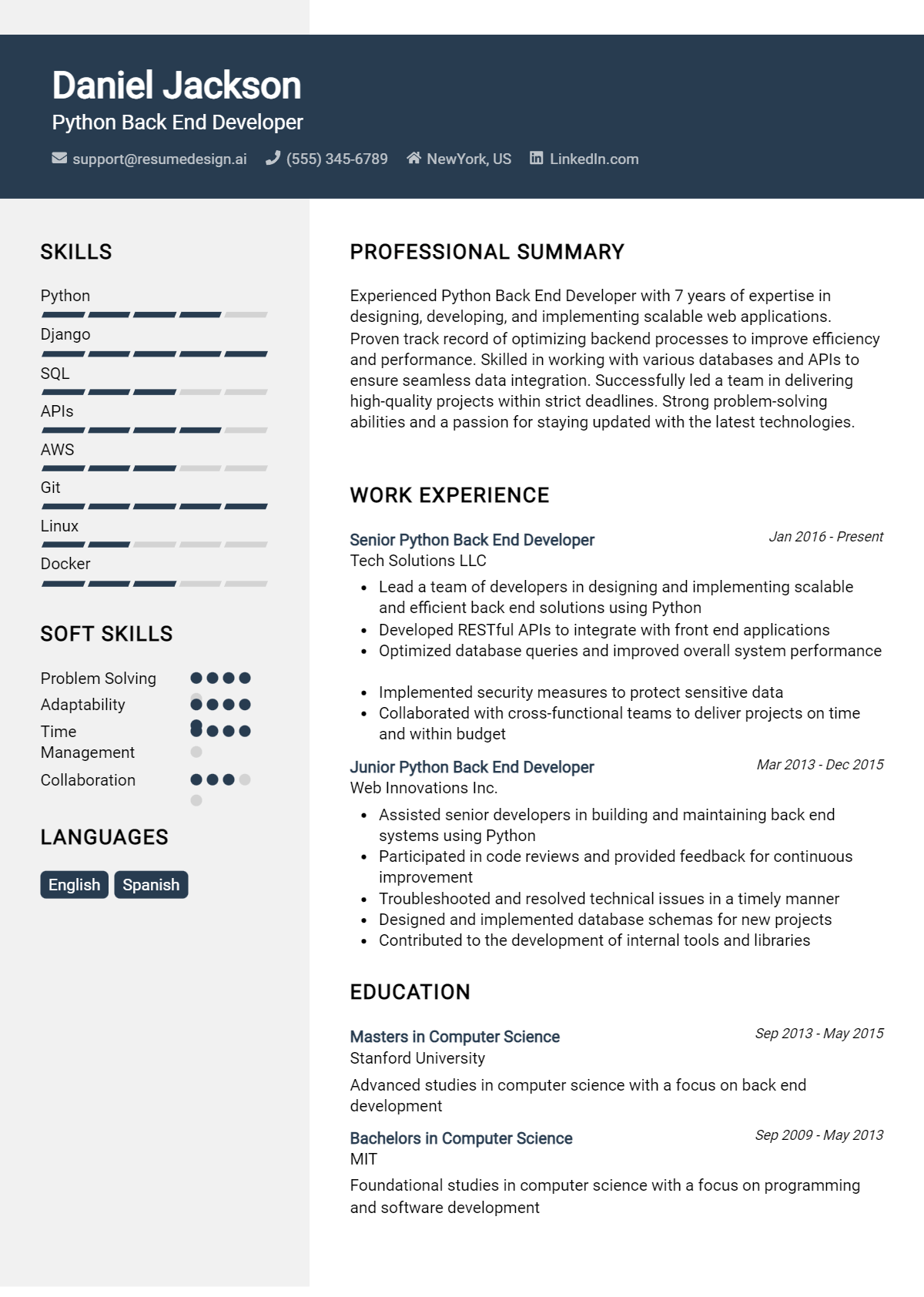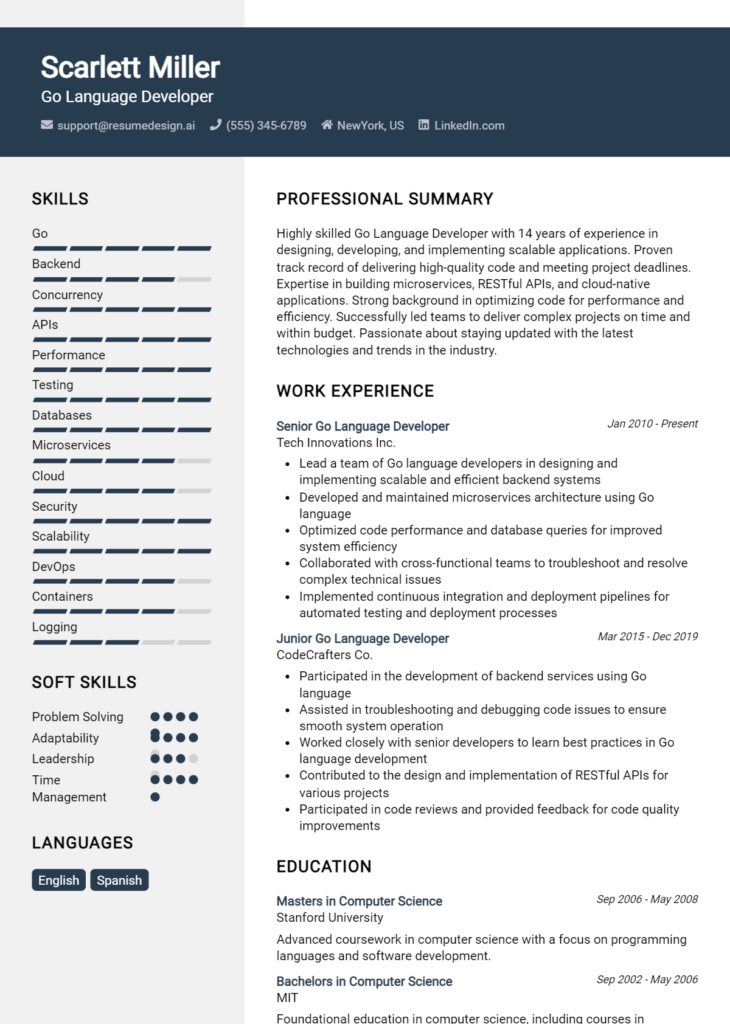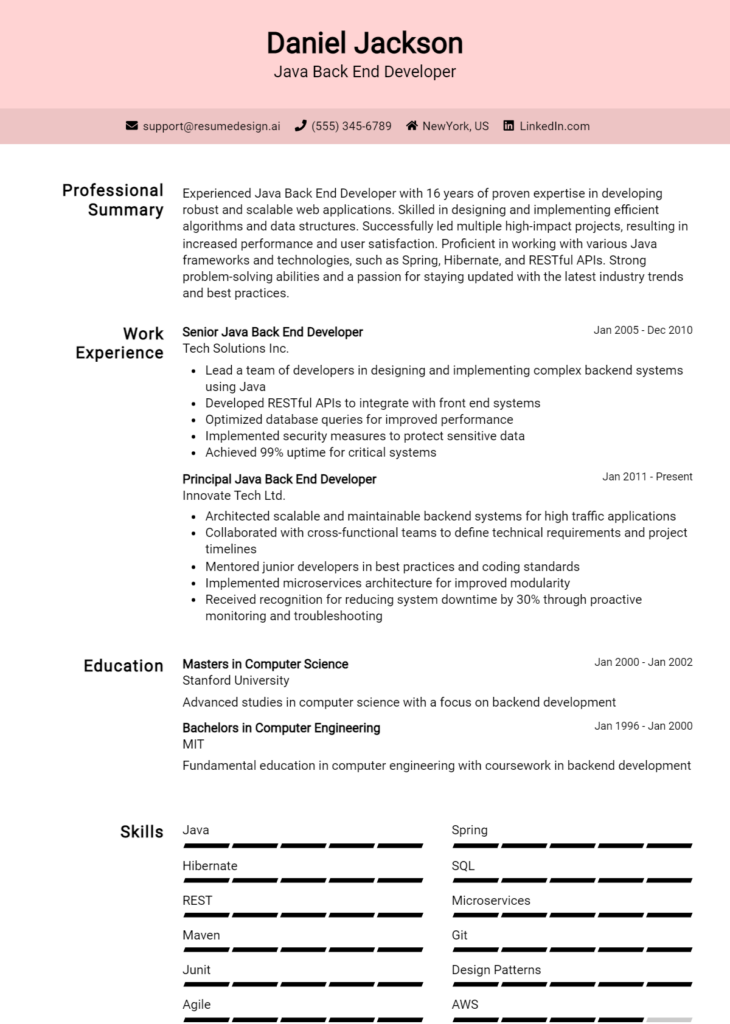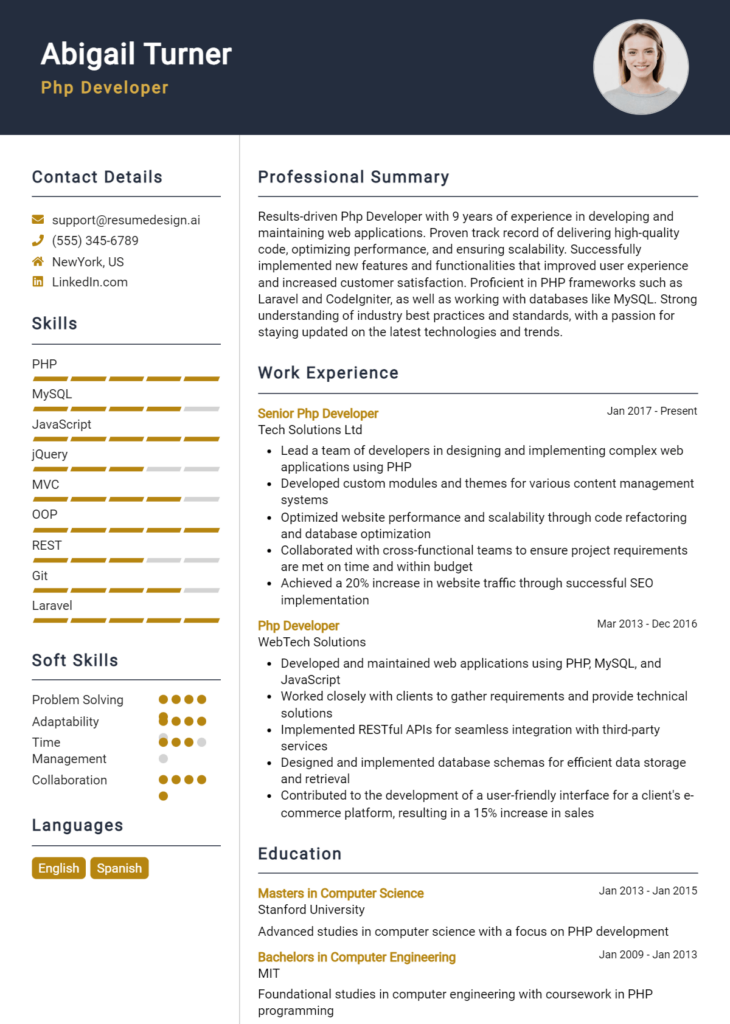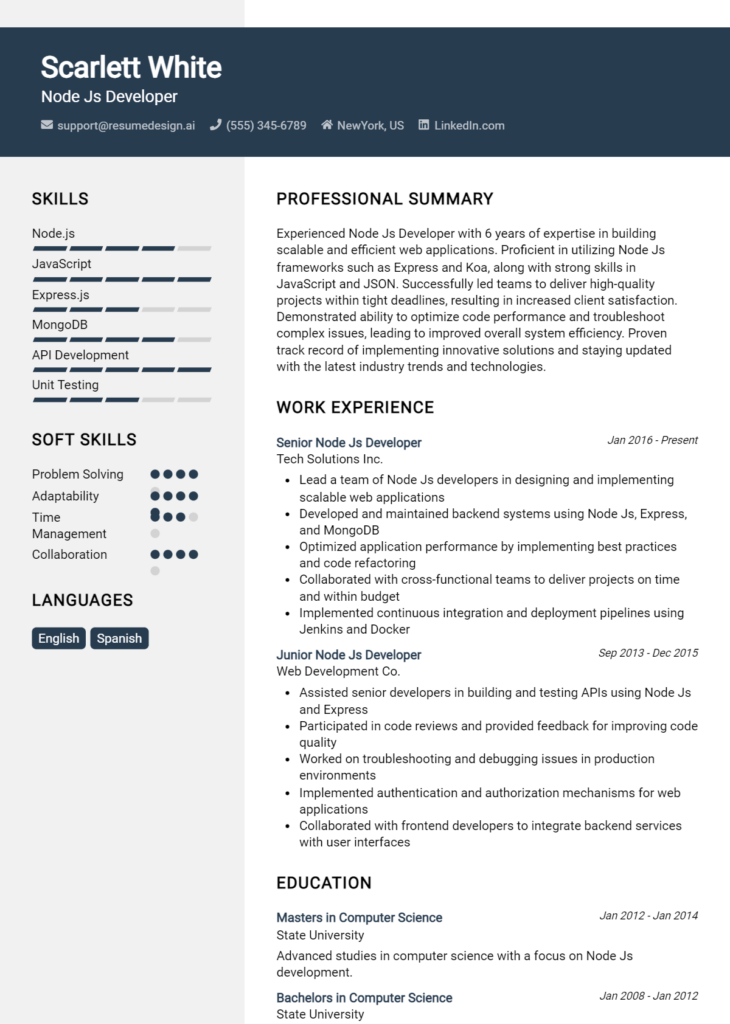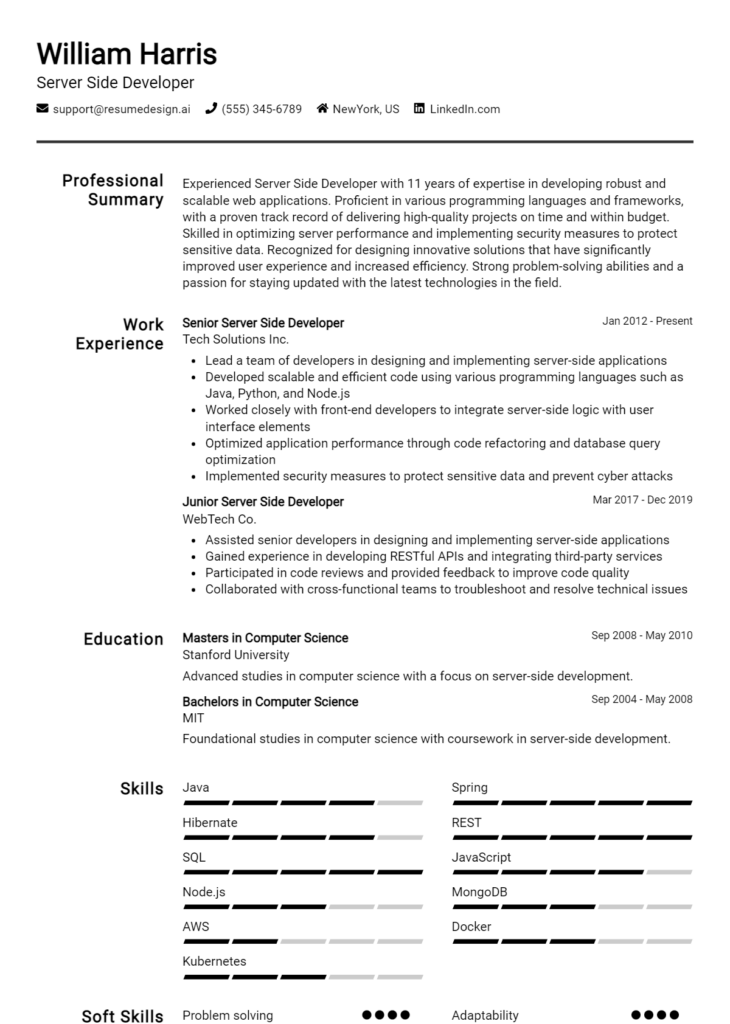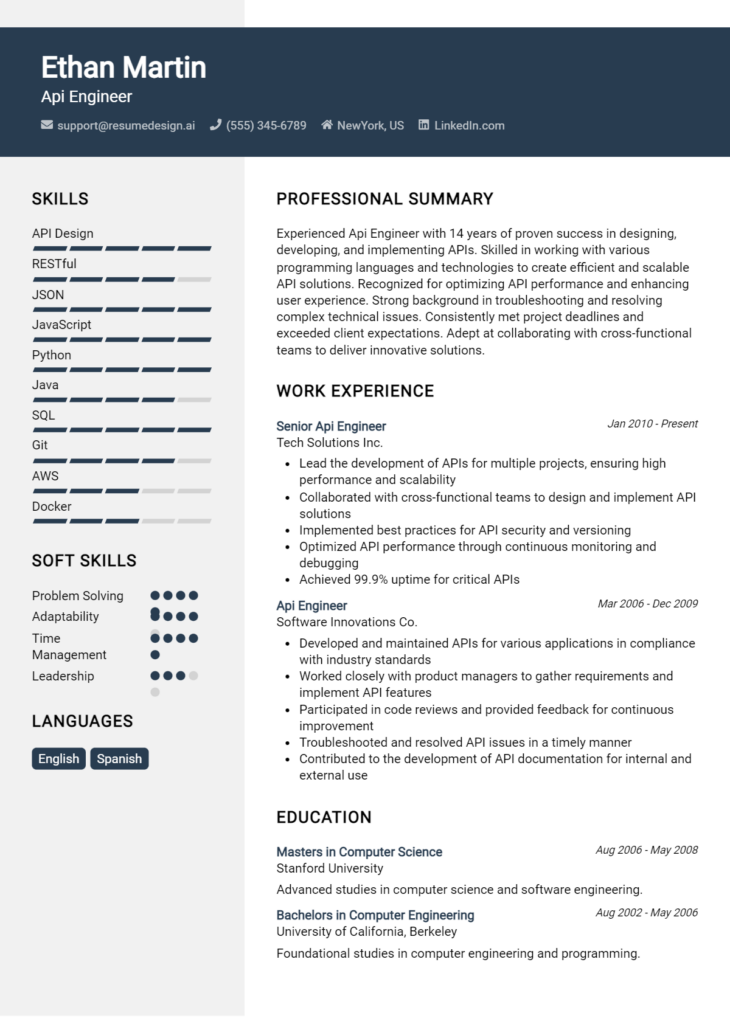Python Back-End Developer Core Responsibilities
A Python Back-End Developer plays a crucial role in building and maintaining server-side applications, ensuring smooth data flow between the server and users. Key responsibilities include writing efficient code, integrating databases, and collaborating with front-end developers to create seamless user experiences. Essential skills encompass strong problem-solving abilities, proficiency in Python frameworks, and a solid understanding of APIs. These technical and operational skills bridge departments, contributing significantly to organizational goals. A well-structured resume can effectively showcase these qualifications, making candidates stand out in the competitive tech landscape.
Common Responsibilities Listed on Python Back-End Developer Resume
- Develop and maintain server-side logic using Python frameworks.
- Collaborate with front-end developers to integrate user-facing elements.
- Design and implement data storage solutions using databases.
- Optimize applications for maximum speed and scalability.
- Ensure data security and protection measures are in place.
- Write reusable, testable, and efficient code.
- Debug and troubleshoot application issues.
- Participate in code reviews and maintain coding standards.
- Monitor and improve application performance.
- Work closely with cross-functional teams to define project requirements.
- Implement APIs and services for data exchange.
- Stay updated with emerging technologies and industry trends.
High-Level Resume Tips for Python Back-End Developer Professionals
A well-crafted resume is crucial for Python Back-End Developer professionals, serving as the first impression a candidate makes on potential employers. In a competitive job market, it's essential that your resume not only showcases your technical skills but also reflects your achievements and contributions in previous roles. A strong resume can open doors to interviews and opportunities, highlighting your unique qualifications for a back-end development position. This guide will provide practical and actionable resume tips specifically tailored for Python Back-End Developer professionals, helping you to stand out in a crowded field.
Top Resume Tips for Python Back-End Developer Professionals
- Tailor your resume to match the specific job description by incorporating relevant keywords and phrases.
- Highlight your experience with Python frameworks such as Django, Flask, or FastAPI to demonstrate your technical proficiency.
- Quantify your achievements by including metrics, such as performance improvements or successful project completions, to provide context to your contributions.
- Showcase your understanding of database management by mentioning experience with SQL, PostgreSQL, or MongoDB.
- Include relevant certifications and training that validate your skills in Python development and related technologies.
- Demonstrate your familiarity with version control systems like Git, emphasizing collaboration and code management skills.
- Highlight any experience with cloud platforms like AWS, Azure, or Google Cloud, as they are increasingly important in back-end development.
- Incorporate examples of your problem-solving abilities by mentioning specific challenges you’ve overcome in previous projects.
- Keep the layout clean and professional, ensuring readability while focusing on key information that recruiters look for.
- Proofread your resume to eliminate any errors or inconsistencies, as attention to detail is vital in software development roles.
By implementing these tips, you can significantly increase your chances of landing a job in the Python Back-End Developer field. A well-structured resume that effectively communicates your skills, achievements, and relevant experiences will not only capture the attention of hiring managers but also position you as a strong candidate in an ever-evolving industry.
Why Resume Headlines & Titles are Important for Python Back-End Developer
In the competitive landscape of job applications, a well-crafted resume headline or title serves as a critical first impression for a Python Back-End Developer. This concise phrase not only captures the attention of hiring managers but also succinctly summarizes a candidate's key qualifications and strengths in relation to the specific role. A strong headline should be impactful, relevant, and tailored to the job being applied for, making it easier for recruiters to recognize the applicant's potential fit within their organization. By skillfully highlighting essential skills, years of experience, or notable achievements, a compelling title can significantly increase the chances of standing out in a crowded applicant pool.
Best Practices for Crafting Resume Headlines for Python Back-End Developer
- Keep it concise: Aim for a headline that is no longer than one sentence.
- Be role-specific: Use terminology and keywords that relate directly to the Python Back-End Developer position.
- Highlight key skills: Incorporate essential skills that are relevant to back-end development, such as Python, Django, or RESTful APIs.
- Showcase experience: Include the number of years or notable projects to indicate expertise.
- Use action-oriented language: Start with strong verbs or adjectives to convey confidence and capability.
- Make it unique: Avoid generic phrases; instead, personalize it to reflect your individual strengths and achievements.
- Consider the job description: Tailor your headline based on the specific requirements of the job listing.
- Keep it professional: Ensure that the tone aligns with industry standards and reflects your professionalism.
Example Resume Headlines for Python Back-End Developer
Strong Resume Headlines
"Experienced Python Back-End Developer Specializing in Microservices Architecture"
“Results-Driven Python Developer with 5+ Years in Scalable Web Applications”
“Innovative Back-End Engineer Proficient in Django and RESTful API Development”
Weak Resume Headlines
“Python Developer”
“Back-End Developer Looking for New Opportunities”
Strong headlines are effective because they clearly communicate a candidate's unique skills and experience relevant to the job they are applying for, capturing the essence of their qualifications in a single, impactful statement. In contrast, weak headlines fail to impress as they lack specificity and do not provide any insight into the candidate's capabilities or aspirations. By being vague or generic, they miss the opportunity to engage hiring managers and effectively convey the candidate's value proposition.
Writing an Exceptional Python Back-End Developer Resume Summary
A well-crafted resume summary is crucial for a Python Back-End Developer, as it serves as the first impression a hiring manager has of a candidate. This brief introduction quickly captures attention by showcasing key skills, relevant experience, and notable accomplishments that align with the job requirements. A strong summary should be concise and impactful, tailored specifically to the position being applied for, allowing the candidate to stand out in a competitive job market and effectively communicate their value to potential employers.
Best Practices for Writing a Python Back-End Developer Resume Summary
- Quantify Achievements: Use numbers and statistics to demonstrate the impact of your work, such as performance improvements or successful project completions.
- Focus on Skills: Highlight the most relevant technical skills, frameworks, and programming languages that pertain to back-end development.
- Tailor to Job Description: Customize your summary for each application to align with the specific requirements and keywords found in the job listing.
- Be Concise: Aim for 3-5 sentences that clearly communicate your qualifications without unnecessary fluff.
- Showcase Relevant Experience: Mention specific projects or roles that illustrate your capabilities in back-end development.
- Use Action Verbs: Start sentences with strong action verbs to convey a sense of proactivity and achievement.
- Include Certifications or Education: If applicable, briefly mention relevant certifications or degrees that enhance your qualifications.
- Maintain Professional Tone: Keep the language professional and focused on your technical competencies and contributions.
Example Python Back-End Developer Resume Summaries
Strong Resume Summaries
Detail-oriented Python Back-End Developer with over 5 years of experience in building scalable web applications. Successfully improved application response time by 30% through optimized database queries and backend refactoring. Proficient in Django and Flask, with a strong understanding of RESTful API design.
Results-driven back-end developer skilled in Python and Node.js, with a proven track record of deploying 10+ microservices in cloud environments. Enhanced system reliability by implementing CI/CD pipelines, reducing deployment times by 50%.
Innovative Python Back-End Developer with expertise in machine learning integration and cloud-based solutions. Developed an automated data processing pipeline that increased data throughput by 40%, leveraging AWS and Docker for deployment.
Weak Resume Summaries
I am a Python Back-End Developer with some experience in various technologies. I have worked on multiple projects and can code well.
Enthusiastic developer looking for a role in back-end development. I enjoy programming and have learned Python and other languages.
The strong resume summaries are considered effective because they provide specific achievements and relevant skills while clearly demonstrating the candidate's impact in previous roles. In contrast, the weak summaries lack detail and quantifiable outcomes, making them generic and unmemorable. A strong summary effectively highlights what sets a candidate apart, while a weak summary fails to engage the hiring manager's interest.
Work Experience Section for Python Back-End Developer Resume
The work experience section of a Python Back-End Developer resume is crucial as it serves as a testament to the candidate's technical skills, project management capabilities, and ability to deliver high-quality products. This section not only highlights the technologies and frameworks the candidate has worked with but also demonstrates their capacity to lead teams and collaborate effectively within diverse environments. By quantifying achievements, such as performance improvements or successful project completions, candidates can create a compelling narrative that aligns their experience with industry standards, making them more attractive to potential employers.
Best Practices for Python Back-End Developer Work Experience
- Clearly outline specific technologies and frameworks used in each role.
- Quantify achievements with metrics, such as reduced load times or increased user engagement.
- Highlight collaborative projects that showcase teamwork and communication skills.
- Emphasize leadership roles or responsibilities that demonstrate management capabilities.
- Use action verbs to convey the impact of your contributions effectively.
- Tailor the work experience to align with the job description and industry standards.
- Include relevant side projects or contributions to open-source software to further demonstrate expertise.
- Avoid jargon or vague descriptions—be specific about your role and contributions.
Example Work Experiences for Python Back-End Developer
Strong Experiences
- Led a team of 5 developers in building a scalable RESTful API, resulting in a 30% increase in application response time and supporting 10,000 concurrent users.
- Implemented a caching strategy using Redis, which improved data retrieval speed by 50%, enhancing overall user experience and engagement.
- Collaborated with front-end developers to integrate microservices, reducing deployment time by 40% and ensuring seamless communication across platforms.
- Designed and developed a robust automated testing framework that decreased bug reports by 25% post-deployment, significantly improving product quality.
Weak Experiences
- Worked with various databases and programming languages.
- Participated in team meetings to discuss project progress.
- Assisted in coding and debugging tasks.
- Helped maintain existing applications and systems.
The examples listed as strong are considered effective because they provide specific, quantifiable outcomes and demonstrate a clear impact on project success and team dynamics. In contrast, the weak experiences lack detail and do not convey a sense of responsibility or achievement, making it difficult for employers to assess the candidate’s capabilities and contributions effectively.
Education and Certifications Section for Python Back-End Developer Resume
The Education and Certifications section of a Python Back-End Developer resume is crucial as it showcases the candidate's academic background and relevant qualifications that are essential for the role. This section not only lists degrees and certifications but also illustrates the candidate's commitment to continuous learning and professional development in the ever-evolving tech landscape. By providing pertinent coursework, specialized training, and industry-recognized certifications, candidates can significantly enhance their credibility and demonstrate their alignment with the expectations of potential employers in the field of back-end development.
Best Practices for Python Back-End Developer Education and Certifications
- Include degrees relevant to computer science, software engineering, or related fields.
- Highlight industry-recognized certifications such as AWS Certified Developer or Microsoft Certified: Azure Developer Associate.
- List relevant coursework that pertains directly to back-end development, databases, or Python programming.
- Emphasize any specialized training or boot camps focused on Python or back-end technologies.
- Use clear formatting to differentiate between degrees, certifications, and additional training.
- Keep the section concise but informative, ensuring it enhances your overall resume.
- Update this section regularly to reflect new certifications or educational achievements.
- Consider including any relevant online courses from recognized platforms like Coursera or Udacity.
Example Education and Certifications for Python Back-End Developer
Strong Examples
- Bachelor of Science in Computer Science, University of Technology (Graduated: 2022)
- Python Developer Certificate, Coursera (Issued: 2023)
- Certified Kubernetes Administrator (CKA), The Linux Foundation (Issued: 2023)
- Relevant Coursework: Advanced Python Programming, Database Management Systems, Web Application Development
Weak Examples
- Associate Degree in Art, Community College (Graduated: 2019)
- Certification in Basic Microsoft Office Skills (Issued: 2021)
- High School Diploma (Graduated: 2015)
- Outdated certification in Java Programming (Issued: 2010)
The strong examples are considered relevant as they directly align with the skills and knowledge required for a Python Back-End Developer role, showcasing pertinent education and certifications that enhance the candidate's qualifications. In contrast, the weak examples highlight educational achievements and certifications that are either irrelevant to back-end development or outdated, which do not contribute positively to the candidate's profile in the context of this specific job role.
Top Skills & Keywords for Python Back-End Developer Resume
A well-crafted resume is essential for any Python Back-End Developer looking to stand out in a competitive job market. Highlighting relevant skills not only showcases your technical proficiency but also demonstrates your ability to contribute effectively to a team and project. A strong skill set, both hard and soft, can significantly enhance your resume, making it more appealing to potential employers. Tailoring your resume to include specific skills relevant to the job description can set you apart from other candidates. Furthermore, showcasing your work experience alongside these skills can provide a comprehensive view of your capabilities and accomplishments.
Top Hard & Soft Skills for Python Back-End Developer
Soft Skills
- Problem-solving
- Communication
- Team collaboration
- Adaptability
- Critical thinking
- Time management
- Attention to detail
- Creativity
- Empathy
- Leadership
Hard Skills
- Proficiency in Python programming
- Understanding of RESTful API development
- Experience with Django or Flask frameworks
- Knowledge of database management (SQL, NoSQL)
- Familiarity with version control systems (Git)
- Understanding of cloud services (AWS, Azure)
- Experience with containerization (Docker, Kubernetes)
- Knowledge of testing frameworks (PyTest, Unittest)
- Ability to write efficient algorithms
- Familiarity with CI/CD pipelines
Stand Out with a Winning Python Back-End Developer Cover Letter
Dear [Hiring Manager's Name],
I am excited to apply for the Python Back-End Developer position at [Company Name], as advertised on [where you found the job listing]. With a robust background in developing scalable web applications and a deep understanding of Python frameworks such as Django and Flask, I am confident in my ability to contribute effectively to your team. My hands-on experience in building RESTful APIs and integrating third-party services aligns well with your requirements, and I am eager to bring my technical skills and passion for back-end development to [Company Name].
In my previous role at [Previous Company], I successfully led a project that involved designing a microservices architecture for a high-traffic e-commerce platform. By leveraging Python and Docker, I reduced the deployment time by 40% and improved system reliability. My attention to detail and commitment to writing clean, maintainable code allowed my team to achieve a significant reduction in bug reports and increased user satisfaction. I am particularly drawn to [Company Name] because of its commitment to innovation and its focus on providing exceptional user experiences, and I am eager to contribute to such exciting projects.
I also possess strong problem-solving skills and enjoy collaborating with cross-functional teams to deliver quality results on time. My experience with database management using PostgreSQL and MongoDB, along with my understanding of cloud services like AWS, has equipped me with the tools necessary to tackle complex back-end challenges. I am enthusiastic about the opportunity to further develop my skills in a dynamic environment like [Company Name] while helping to create robust and efficient back-end solutions.
Thank you for considering my application. I look forward to the opportunity to discuss how my skills and experiences align with the goals of [Company Name]. I am eager to contribute to your team and help drive your projects to success.
Sincerely,
[Your Name]
[Your LinkedIn Profile]
[Your Contact Information]
Common Mistakes to Avoid in a Python Back-End Developer Resume
When crafting a resume for a Python Back-End Developer position, it's crucial to present your skills and experiences effectively to stand out in a competitive job market. However, many applicants make common mistakes that can diminish their chances of landing an interview. Understanding and avoiding these pitfalls can significantly enhance your resume's impact and clarity. Here are some prevalent mistakes to be aware of:
Generic Objective Statements: Using a broad or vague objective that doesn't highlight your specific skills or career goals can make your resume forgettable. Tailor your objective to reflect your passion for back-end development and your expertise in Python.
Overloading with Technical Jargon: While it's essential to showcase your technical skills, bombarding the reader with excessive jargon can make your resume hard to read. Strike a balance by using clear terminology that conveys your knowledge without alienating non-technical reviewers.
Neglecting Soft Skills: Focusing solely on technical abilities while ignoring soft skills such as teamwork, communication, and problem-solving can create an incomplete picture. Highlight how your interpersonal skills contribute to project success and team dynamics.
Lack of Quantifiable Achievements: Simply listing responsibilities from previous roles doesn't demonstrate your impact. Use metrics and specific outcomes to illustrate your achievements, such as improving application performance by a certain percentage or reducing load times.
Inconsistent Formatting: A cluttered or inconsistent layout can distract from the content of your resume. Maintain a clean, professional appearance with uniform font sizes, headings, and spacing to enhance readability.
Ignoring Keywords from Job Descriptions: Failing to incorporate relevant keywords from the job description can result in your resume being overlooked by applicant tracking systems (ATS). Tailor your resume for each application by including specific terms related to the position.
Including Irrelevant Experience: Listing unrelated work experience can dilute the relevance of your resume. Focus on showcasing experiences that directly relate to back-end development and your proficiency in Python.
Omitting Continuous Learning: In the tech industry, skills and frameworks evolve rapidly. Failing to mention ongoing education, certifications, or personal projects can give the impression that you’re not staying current with industry trends.
Conclusion
In summary, a Python Back-End Developer plays a crucial role in creating robust and efficient server-side applications. Key responsibilities include designing APIs, managing database interactions, and ensuring system performance and security. Proficiency in Python frameworks, database management systems, and version control is essential for success in this role. Additionally, soft skills such as problem-solving, communication, and teamwork are invaluable in collaborating with front-end developers and stakeholders.
As you reflect on your career and your qualifications for this exciting position, it’s essential to ensure your resume stands out. Take a moment to review your Python Back-End Developer resume and make sure it highlights your skills and experience effectively.
To assist you in this process, consider utilizing available resources such as resume templates, which can help you structure your resume professionally. You can also use a resume builder for a user-friendly way to create a polished document. For inspiration, check out resume examples that showcase successful Python Back-End Developer profiles. Lastly, don’t forget the importance of a compelling first impression with your application: explore cover letter templates to craft a persuasive introduction.
Take action now to enhance your resume and position yourself as a top candidate in the competitive field of Python Back-End Development!

